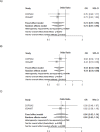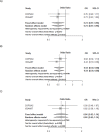Prenatal vitamin D supplementation reduces risk of asthma/recurrent wheeze in early childhood: A combined analysis of two randomized controlled trials
- PMID: 29077711
- PMCID: PMC5659607
- DOI: 10.1371/journal.pone.0186657
Prenatal vitamin D supplementation reduces risk of asthma/recurrent wheeze in early childhood: A combined analysis of two randomized controlled trials
Abstract
Background: We recently published two independent randomized controlled trials of vitamin D supplementation during pregnancy, both indicating a >20% reduced risk of asthma/recurrent wheeze in the offspring by 3 years of age. However, neither reached statistical significance.
Objective: To perform a combined analysis of the two trials and investigate whether maternal 25-hydroxy-vitamin D (25(OH)D) level at trial entry modified the intervention effect.
Methods: VDAART (N = 806) and COPSAC2010. (N = 581) randomized pregnant women to daily high-dose vitamin D3 (4,000 IU/d and 2,400 IU/d, respectively) or placebo. All women also received a prenatal vitamin containing 400 IU/d vitamin D3. The primary outcome was asthma/recurrent wheeze from 0-3yrs. Secondary end-points were specific IgE, total IgE, eczema and lower respiratory tract infections (LRTI). We conducted random effects combined analyses of the treatment effect, individual patient data (IPD) meta-analyses, and analyses stratified by 25(OH)D level at study entry.
Results: The analysis showed a 25% reduced risk of asthma/recurrent wheeze at 0-3yrs: adjusted odds ratio (aOR) = 0.74 (95% CI, 0.57-0.96), p = 0.02. The effect was strongest among women with 25(OH)D level ≥30ng/ml at study entry: aOR = 0.54 (0.33-0.88), p = 0.01, whereas no significant effect was observed among women with 25(OH)D level <30ng/ml at study entry: aOR = 0.84 (0.62-1.15), p = 0.25. The IPD meta-analyses showed similar results. There was no effect on the secondary end-points.
Conclusions: This combined analysis shows that vitamin D supplementation during pregnancy results in a significant reduced risk of asthma/recurrent wheeze in the offspring, especially among women with 25(OH)D level ≥ 30 ng/ml at randomization, where the risk was almost halved. Future studies should examine the possibility of raising 25(OH)D levels to at least 30 ng/ml early in pregnancy or using higher doses than used in our studies.
Trial registration: COPSAC2010: ClinicalTrials.gov NCT00856947; VDAART: ClinicalTrials.gov NCT00920621.
Conflict of interest statement
Figures



References
-
- Raby BA, Lazarus R, Silverman EK, Lake S, Lange C, Wjst M, et al. Association of Vitamin D Receptor Gene Polymorphisms with Childhood and Adult Asthma. Am J Respir Crit Care Med. 2004;170: 1057–1065. doi: 10.1164/rccm.200404-447OC - DOI - PubMed
-
- Kho AT, Sharma S, Qiu W, Gaedigk R, Klanderman B, Niu S, et al. Vitamin D related genes in lung development and asthma pathogenesis. BMC Med Genomics. 2013;6: 47 doi: 10.1186/1755-8794-6-47 - DOI - PMC - PubMed
-
- Litonjua AA. Childhood asthma may be a consequence of vitamin D deficiency. Curr Opin Allergy Clin Immunol. 2009;9: 202–207. doi: 10.1097/ACI.0b013e32832b36cd - DOI - PMC - PubMed
-
- Devereux G, Litonjua AA, Turner SW, Craig LC, McNeill G, Martindale S, et al. Maternal vitamin D intake during pregnancy and early childhood wheezing. The American Journal of Clinical Nutrition. 2007;85: 853–859. - PubMed
Publication types
MeSH terms
Substances
Associated data
Grants and funding
LinkOut - more resources
Full Text Sources
Other Literature Sources
Medical

